‘Spielberg told us not to shoot on water’: how Waterworld almost sank Kevin Costner

In April 2019, writer and filmmaker Peter Rader attended a round table at the United Nations headquarters. Rader was there, alongside architects, engineers and developers, to discuss the building of a prototype island city – a concept being quite literally floated as a solution to rising sea levels and overcrowded coastal cities.
Rader recalls that hotshot Danish architect Bjarke Ingels led the discussion: “At the end of his presentation Bjarke said, ‘As you can see, this is very well thought-out plan… not a disaster like Kevin Costner’s Waterworld!’”
Ingels didn’t realise that the next speaker was Rader – the original writer of Waterworld. “I had the joy of saying, ‘Hey Bjarke, when you threw mad shade on Kevin Costner, I bet you didn’t think the screenwriter would be called up next!'” laughs the writer today.
Ingels was also wrong about Waterworld. Famed for being the most expensive film ever-turned-titanic flop, Waterworld wasn’t a box office disaster. (“And it was the most expensive film of all time for about five minutes,” says Rader.)
Certainly, the film was a storm of production problems: at the mercy of the ocean, with an ever-escalating overspend and brutal treatment by the press. It was dubbed “Kevin’s Gate” and “Fishtar” – after notorious flops Heaven's Gate and Ishtar – before a single frame was screened. Waterworld grossed $264 million ("That's not chump change!" says Rader). For an indication of what the film means to Universal, the Waterworld stunt show has been packing crowds into theme parks around the world for 25 years.
Parts of Waterworld are inspired; other parts, of course, are a big wet disappointment. But it’s also a fascinating piece of blockbuster cinema, made on the cusp of the transition from practical and digital effects, when summer blockbusters were less of a sure thing – sold on the spectacle of originality, not brand recognition.
Set in the future, when the polar ice caps have melted and covered the Earth’s surface in oceans, Waterworld follows the adventures of Costner's fish-man (well, a man with gills and webbed toes) The Mariner, who sails grumpily alone. After a run-in with the dreaded “Smokers” – pollutant, cigarette-chugging villains, led by The Deacon (a deranged Dennis Hopper) – The Mariner rescues Helen (Jeanne Triplehorn) and Elona (Tina Majorino) and searches for mythical "dry land".
First written in 1986, Waterworld has become like an old tale from the sea itself. Rader, looking for his break as a director, met with Brad Krevoy, an executive working under B-movie maestro Roger Corman. These were the days of “selling in” knockabout genre flicks to secure financing.
“Listen Peter, I’ve got some South African money,” said Krevoy. “If you write me a Mad Max rip-off, I’ll let you direct it.”
Though hesitant about the idea, Rader was hit by a wave of inspiration while walking through a marina. He went back to Krevoy and told him the idea: “Here’s what we’re going to do… Mad Max on water.”

“Are you out of your mind? Mad Max on water?!” said Krevoy. “That would cost us $5 million! Forget it, we’re not doing it.’”
Regardless, Rader wrote the script and shelved it for three years. He returned to the script and – driven by the frustrations of directing some low-budget features – decided to let his imagination “run wild”.
Producer brothers Lawrence and Charles Gordon picked up the script. The Gordons ultimately took it to Universal due the escalating budget. What began as a $65 million movie, swelled to $100 million, and eventually cost an eye (and everything else) watering $175 million. (GoldenEye – released the same year and hardly a slouch in the action and spectacle front – cost around $60 million.)
The first that Peter Rader knew about Kevin Costner’s involvement was through a friend, who happened to pass by Costner one day at Universal.
“She was driving along in a golf cart and Kevin Costner was walking along with another guy,” recalls Rader. “She drives by and hears just one snippet from their conversation – ‘Waterworld’. I called my agent and said, ‘Is Kevin Costner interested in Waterworld?!’ They said, ‘How the hell did you find out?!’”
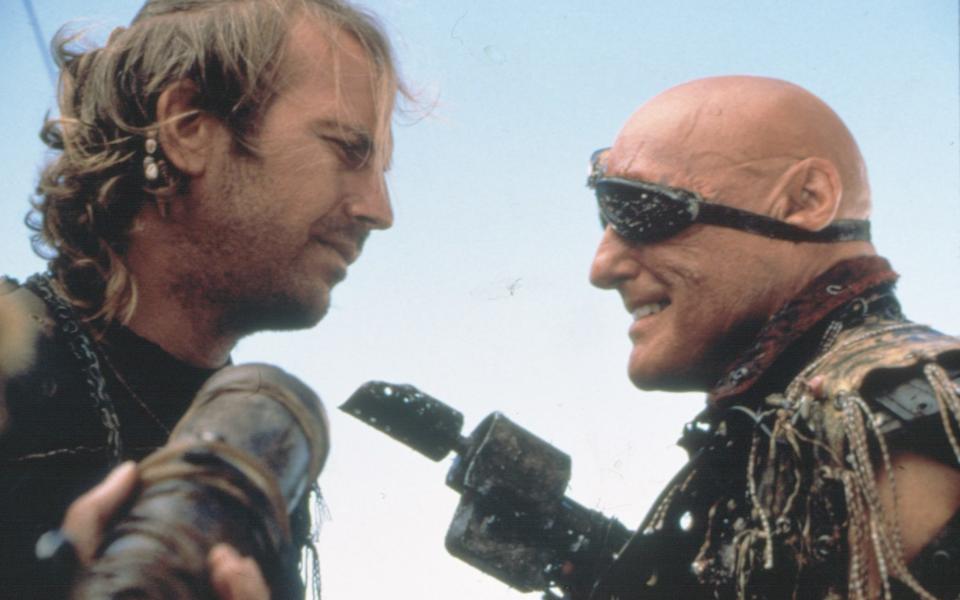
Kevin Reynolds – who had directed Costner in Fandango and Robin Hood: Prince of Thieves – had read it independently of Costner. He was hooked by what he later described as a “Statue of Liberty moment in Planet Of The Apes.”
“Unbeknownst to me,” said Reynolds, “at the same time Costner had read it as well.”
The pair had been friends since Costner auditioned for Reynolds at the University of Southern California. But the Kevins had a spectacular falling out over creative control on Prince of Thieves. Still, Costner passed over the likes of Robert Zemeckis and insisted that Reynolds direct Waterworld. “Ultimately, because he knew he could control Reynolds,” says Rader.
To settle whatever differences they had, Charles Gordon stuck them in a room at the Peninsula Hotel in Beverly Hills. As Rader explains: “Charles Gordon said, ‘Here’s what we’re going to do – I’ll get a suite, order room service for 48 hours, and you guys will hash it out. You won’t leave this room until you find a way of making this movie together.’ They had a lot of history together. I guess they said, ‘OK let’s do this together,’ but by the time production was over…’”
Rader admits he was “naïve” about what would happen to his script once Reynolds and Costner were on-board.
“It went into the world of development hell,” Rader says “When I sold the script I didn’t realise there was even an option for me to be replaced as writer. I couldn’t understand that concept.”
Rader wrote seven drafts himself and shared the screenwriting credit with David Twohy, who Rader credits for punching up the characterisation and creating Hopper's villain. Multiple other writers were brought on at various stages. Rader estimates 20 drafts in total.
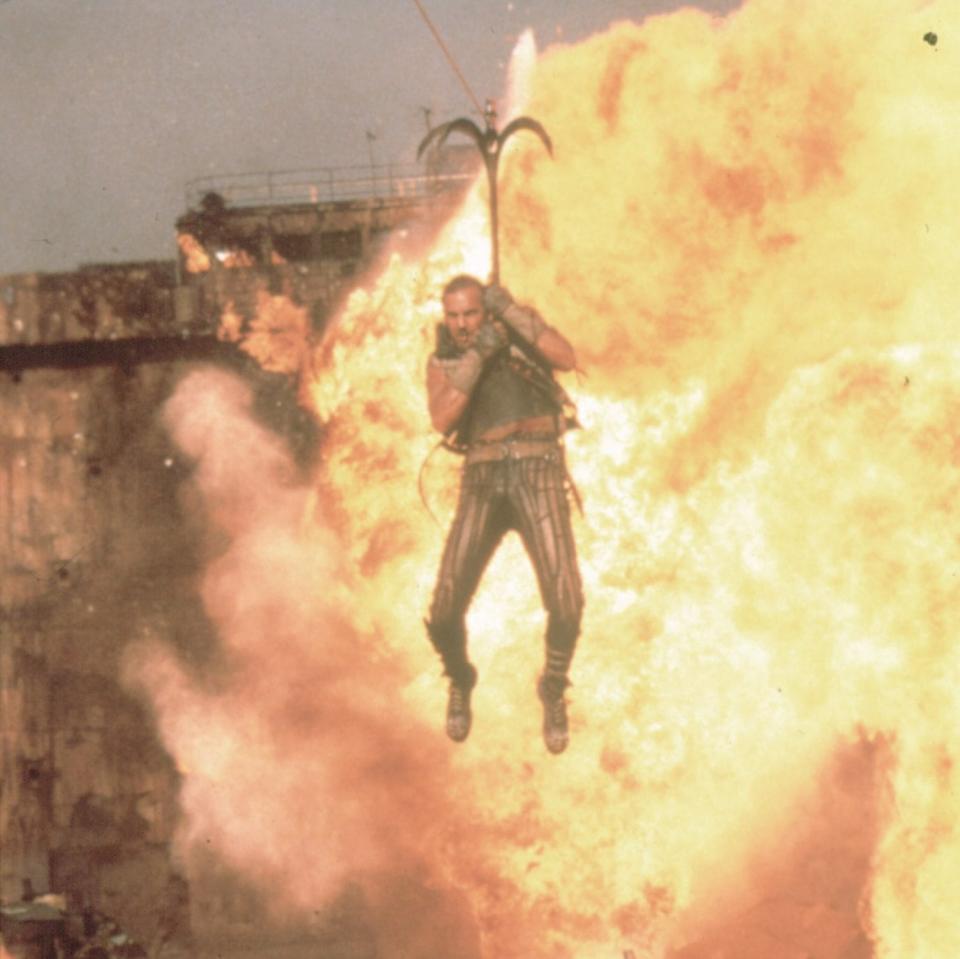
The very first scene – which sees Costner’s Mariner filtering his own urine and drinking it back down – was taken from Rader’s original version. He’s since described how his original villains had nautical-themed appendages, like crab claw arms.
“Those of us who are creators in this field always want our work to be elevated,” says Rader. “But in these situations it becomes a bit of a pissing contest. It’s ‘I want it my way, not your way,’ even though it’s no better or worse, just a horizontal change. There are lots of cooks in the kitchen with a movie like this – writers, executives, producers. It just gets written into the ground. It loses its spark.”
Waterworld’s biggest problems were yet to come, with the decision to shoot on the water at Kawaihae Harbor, off of the Big Island of Hawaii. Reynolds went to Steven Spielberg for advice; the Jaws shoot had overrun from 55 to 155 days, so Spielberg was a wisened old sea dog.
“Spielberg was unequivocal,” says Rader. “He said, ‘Don’t shoot on water. Shoot it in a tank, shoot it on a stage. Just get your vistas on the ocean. Everything else, take it off the water.’ They said, ‘Oh yeah, we’re going to ignore Steven Spielberg. Let’s give it that gritty feeling and do it practically.’ I understand that creative decision but it came at a price.”
Waterworld does look incredible, largely thanks to cinematographer Dean Semler, who also worked on the Mad Max movies, and production designer Dennis Gassner.
The biggest set (other than the ocean itself) was a floating atoll – a makeshift maritime town and trading port in the movie – which was constructed with 1,000 tons of steel. It was so massive, reportedly the same circumference as a football stadium, that it took four cranes to lift each individual section. It could be rotated and pulled in and out of the harbor and sea. “The set wasn't a three-ring circus, it was a 12-ring circus,” Reynolds told Newsweek in 2015. “The scale was enormous.”
The boats used for the Mariner’s trademark ride, a super-fast trimaran, cost $1 million each. Other boats had to be flown to Hawaii in pieces by a 747. To accommodate the deliveries, Kona airport had to extend its runway by a quarter of a mile. Already, there were rumours about the cost.
“It became a very expensive movie,” said Charles Gordon, speaking on the 2018 documentary Maelstrom: The Odyssey of Waterworld. “Immediately, everybody was saying we were over budget. We hadn’t even started shooting.”
Peter Rader recalls going to lunch with Gordon two months before principal photography began. Gordon told him: “Peter, we have yet to come up with a script that’s as good as your original spec script.”
“What?! Why don’t you just shoot that?” Rader asked.
“The train has left the station,” replied Gordon. “We’ve built sets. We’ve committed to this other version.”
As Spielberg had warned, there were problems shooting on the water from the very first take. Rader describes how ocean shots required an entire flotilla to head two or three miles out to sea – “The picture boat, the camera boat, the catering boat, the wardrobe boat,” Rader says. “A frickin’ armada needs to be geared up and assembled!”
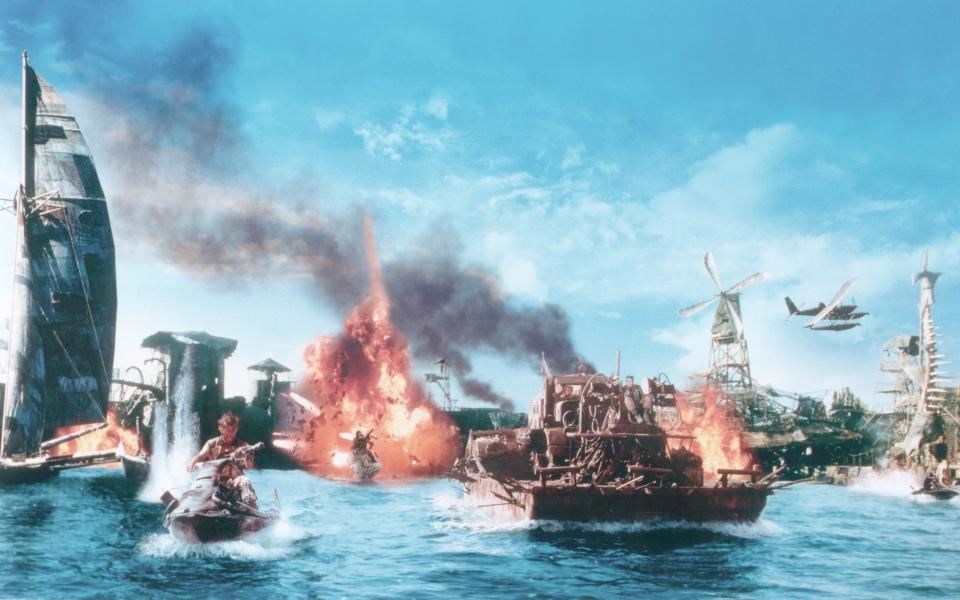
There were scary moments too: Jeanne Triplehorn and Tina Majorino were swept off the trimaran by a wave and had to be fished out of the water by divers; and Costner, while fastened to the mast for a specific shot, was suddenly whipped about by heavy winds and hammered by the water. One of the smaller floating sets sank. Rader recalls being met with glares when he visited the set.
“I was thinking, ‘Why are they glaring at me?’” he laughs. “The reason was that they were three weeks into production and three weeks behind! I don’t think they'd got a single day's worth of shooting yet.”
Speaking on the Maelstrom documentary, Kevin Reynolds explained that he made an early decision to keep the journalists off-set. But the press seized on the production. Costner was also going through a divorce. It was pure tabloid fodder.
“I think every summer the press picks a punching bag – one film that they really go after,” says Rader. “It was a perfect storm, because they got to go after the film and Kevin Costner. It was like, ‘This is juicy, let’s go!’ It went way over budget, but many movies do. They decided to hone it one this one, to call it a disaster and make that the narrative.”
The Los Angeles Times reported crew walkouts, mass vomiting from seasick cast and crew, and ominous visits from Universal executives; People Magazine called it “Kevin Costner's Hawaii Uh-Oh”; and the Wall Street Journal reported on the toilet facilities, or lack of them. Costner was annoyed by reports that his hair was being digitally enhanced in post-production, and that the gills on the side of his neck resembled "little vaginas".
More seriously, the actor's stunt double was hospitalised with a near-fatal embolism after film a deep-diving scene.
According to Reynolds, shooting overran from 120 to 166 days. His first cut of the film was darker, and more pensive that the producers and executives wanted. Rader heard about tensions between Reynolds and Costner second hand.
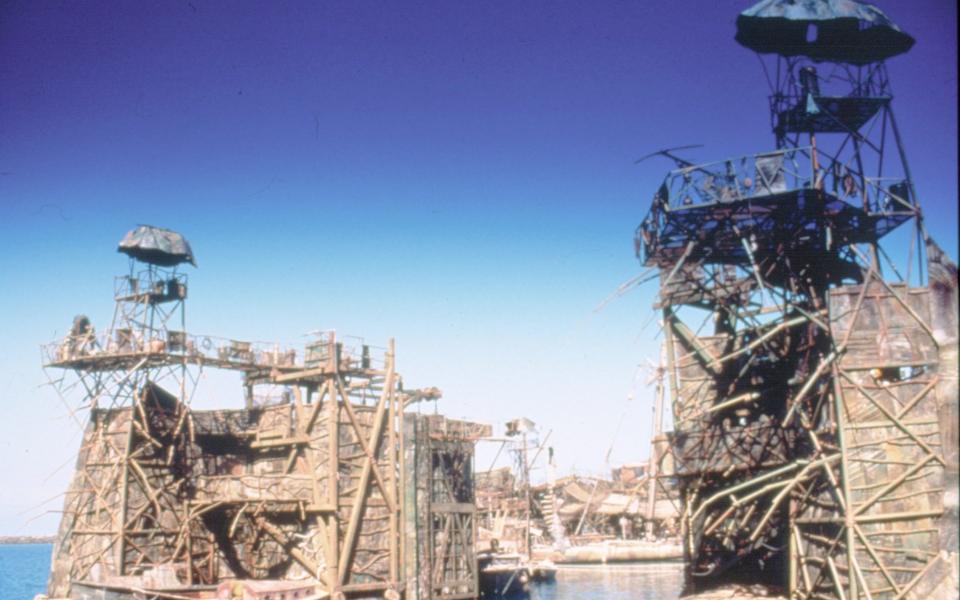
“I was hearing about it in the press and from the occasional call,” he says. “Things like, ‘Oh my god! He’s locking Reynolds out of the edit room!'”
Reynolds quit the film weeks before completion. Costner reportedly took over and even threw out the score. He hired composer James Newton Howard to knock together a new (and quick) swashbuckler of a score.
Waterworld is at its best in the first act, still a masterclass of world-building: the design of the (still impressive) atoll; the costumes, made from whatever materials are still available to the survivors (the fishing net hats are especially good); and a mythology that extends far beyond seaview: they trade in dirt, drinking water, and what precious little vegetation still exists (Costner clings to a tomato plant like other movie heroes would cling to a briefcase full of cash).
The first major set-piece, in which the Smokers descend on and destroy the atoll is the film excelling at excess: stunts, special effects, and Kawasaki jet skis firing in all directions.
While the hero is Costner's dour Mariner (Rader says he's inspired by westerns; Reynolds says he was inspired by the misery of Costner's divorce), the film is best viewed through the eyes – well, eye – of Dennis Hopper's Deacon, one of several madcap villains he played at the time (see also Super Mario Bros and Speed).
Riding on the Exxon Valdez – the tanker which spilled over 10 million gallons of oil off the coast of Alaska – The Deacon could be a work of post-modern comic brilliance. Hero worshipping the Valdez's real-life captain, Joseph Hazelwood, bantering with 10-year-old Elona, and failing to rally his Smokers (essentially disenfranchised pirates) which rubbish speeches, he's less Marlon Brando Colonel Kurtz and more Dustin Hoffman's Captain Hook (another famous creative dud I unashamedly love).
Waterworld doesn’t so much fall off a cliff – cliffs are hundreds of feet below the surface, of course – but gets caught in a tsunami of its own creative confusion. Much like the characters searching for dry land, it’s searching for a final act. Instead, we get a mess of explosions that end with Costner bungee jumping off an ill-judged flying contraption (“That floating Chitty Chitty Bang Bang," says Rader. "It doesn’t work, that’s the wrong movie!”)
Joss Whedon had been brought on for last minute rewrites to fix the final act. “I was there basically taking notes from Costner, who was very nice, fine to work with, but he was not a writer,” said Whedon in 2001. He was supposed to be there for just one week, but got stuck for seven. “And I accomplished nothing,” Whedon said. “I wrote a few puns, and a few scenes that I can't even sit through because they came out so bad.”
Reynolds was disappointed to see the “Planet of the Apes” moment was cut: after landing on dry land, Helen and Enola discover a plaque that reveals they're actually standing on the lush green summit of Mount Everest. The scene – plus 40 additional minutes – were added for an extended “Ulysses” cut.
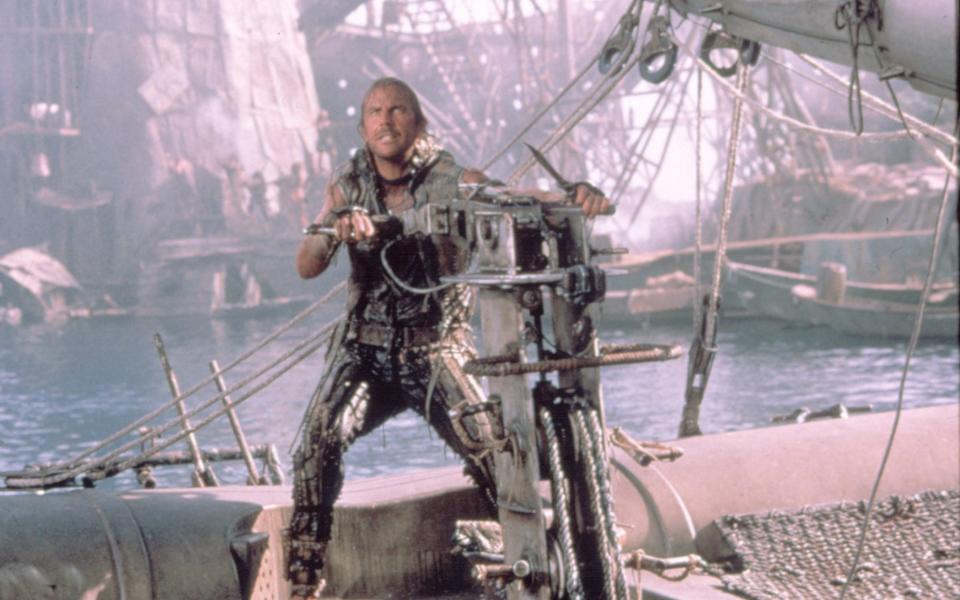
Rader met his wife just weeks before the premiere. She had seen the film before him at a preview screening. “She was not a big fan,” Rader laughs. "And she was not shy about telling me that. That's the reason she got me. I thought, ‘I like this girl!’”
Two weeks later he attended the premiere. It was a huge event. “People wanted to see this thing – to see if it was as big a disaster as everyone said,” he says. Rader was "exhilarated, excited, pleasantly surprised, and slightly disappointed.”
Opening on July 28, 1995, Waterworld debuted at No. 1 and made $264 million worldwide. Legendary agent and executive Lew Wasserman told Kevin Reynolds that the bad publicity had likely cost the box office $50 million. “The press seemed to want it to fail,” Reynolds said.
But it was also a hit on video. Universal also wrote off a sizable chunk of the cost as a part of corporate takeover, when the Seagram Company bought out Universal’s parent company MCA.
The theme park attraction – Waterworld: A Live Sea War Spectacular – opened at Universal Studios in 1995 and has since opened at Universal theme parks in Japan and Singapore. It’s also planned for the still-under-construction Universal Studios Beijing.
Though ultimately a hit, Waterworld did hurt Costner’s star status. After a run of huge films – The Untouchables, JFK, Bull Durham, Field of Dreams, Dances With Wolves, Prince of Thieves, The Bodyguard – he ranked among the biggest movie stars in the world.
The tidal wave of negativity around Waterworld repositioned him as a creatively difficult, self-indulgent ego-maniac. The reputation wasn't helped by similarly-themed apocalyptic non-adventure, The Postman, in 1997. Costner regained his kudos with smaller, mid-tier movies such as Thirteen Days, 3000 Miles to Graceland, and Mr Brooks.
"One thing about Hollywood which is problematic, is that rapid success can be very ego inflating," says Rader. But Rader himself has a good perspective on the movie: "Waterworld was an extraordinary adventure and continues to be."
For more on Peter Rader visit here


